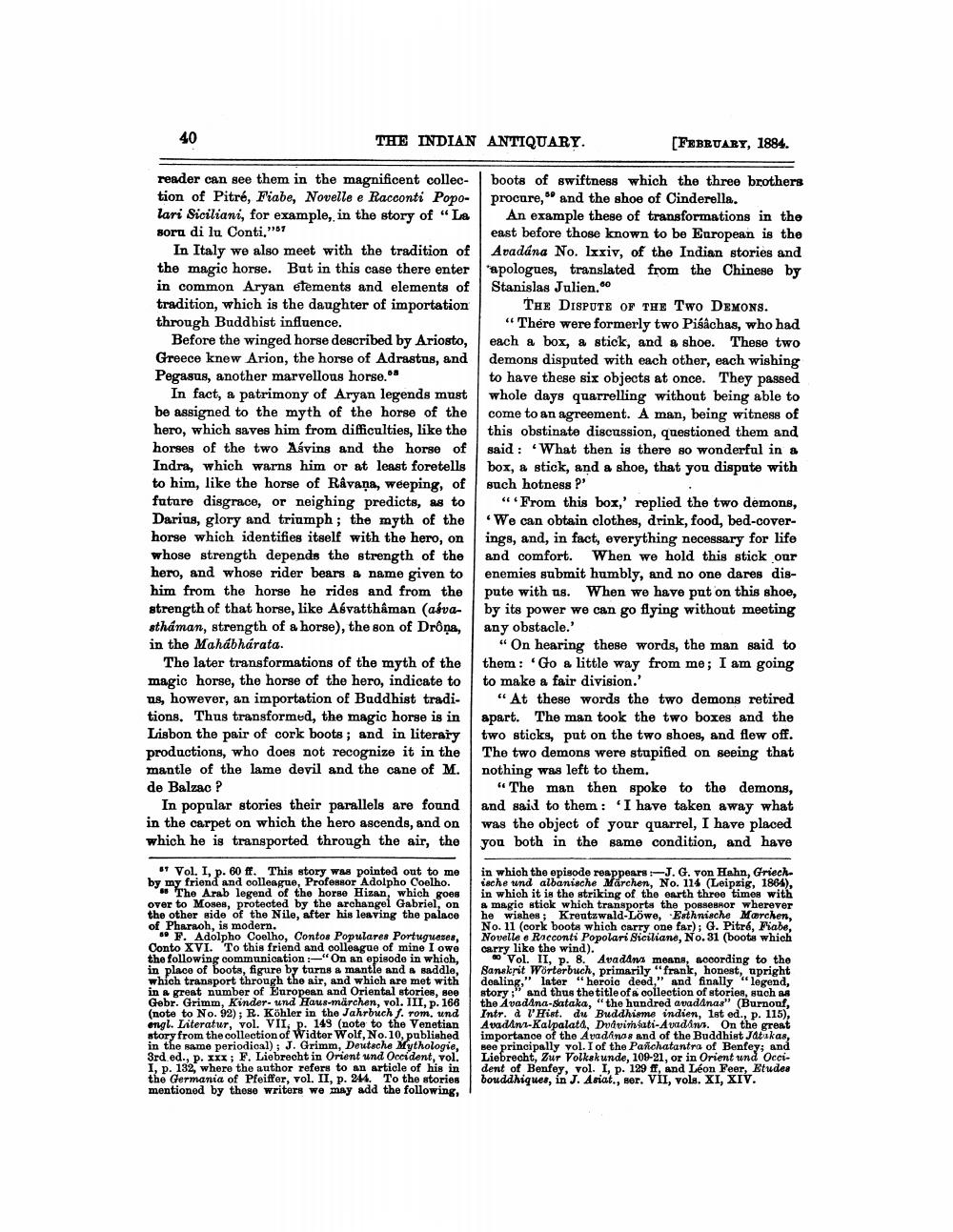________________
40
THE INDIAN ANTIQUARY.
[FEBRUARY, 1884.
reader can see them in the magnificent collec- boots of swiftness which the three brothers tion of Pitré, Fiabe, Novelle e Racconti Popo- | procure, and the shoe of Cinderella. lari Siciliani, for example, in the story of "La An example these of transformations in the soru di lu Conti,"67
east before those known to be European is the In Italy we also meet with the tradition of Aradána No. lxxiv, of the Indian stories and the magic horse. But in this case there enter apologues, translated from the Chinese by in common Aryan elements and elements of Stanislas Julien." tradition, which is the daughter of importation THE DISPUTE OF THE TWO DEMONS. through Buddhist influence.
“There were formerly two Piśâchas, who had Before the winged horse described by Ariosto, each a box, a stick, and a shoe. These two Greece knew Arion, the horse of Adrastus, and demons disputed with each other, each wishing Pegasus, another marvellous horse."
to have these six objects at once. They passed In fact, a patrimony of Aryan legends must whole days quarrelling without being able to be assigned to the myth of the horse of the come to an agreement. A man, being witness of hero, which saves him from difficulties, like the this obstinate discussion, questioned them and horses of the two Asvins and the horse of said: "What then is there so wonderful in a Indra, which warns him or at least foretells box, & stick, and a shoe, that you dispute with to him, like the horse of Råvana, weeping, of such hotness P' future disgrace, or neighing predicts, as to "From this box,' replied the two demons, Darina, glory and triumph; the myth of the We can obtain clothes, drink, food, bed-coverhorse which identifies itself with the hero, on ings, and, in fact, everything necessary for life whose strength depends the strength of the and comfort. When we hold this stick our hero, and whose rider bears a name given to enemies submit humbly, and no one dares dishim from the horse he rides and from the pute with us. When we have put on this shoe, strength of that horse, like Asvatthaman (asva- by its power we can go flying without meeting sthaman, strength of a horse), the son of Drôņa, any obstacle.' in the Mahabharata.
"On hearing these words, the man said to The later transformations of the myth of the them: 'Go a little way from me; I am going magic horse, the horse of the hero, indicate to to make a fair division.' us, however, an importation of Buddhist tradi- "At these words the two demons retired tions. Thus transformed, the magic horse is in apart. The man took the two boxes and the Lisbon the pair of cork boots; and in literary two sticks, put on the two shoes, and flew off. productions, who does not recognize it in the The two demons were stupified on seeing that mantle of the lame devil and the cane of M. nothing was left to them. de Balzac ?
"The man then spoke to the demons, In popular stories their parallels are found and said to them: 'I have taken away what in the carpet on which the hero ascends, and on was the object of your quarrel, I have placed which he is transported through the air, the you both in the same condition, and have
67 Vol. I, p. 60 ff. This story was pointed out to me by my friend and colleague, Professor Adolpho Coelho.
# The Arab legend of the horse Hizan, which goes over to Moses, protected by the archangel Gabriel, on the other side of the Nile, after his leaving the palace of Pharaoh, is modern,
* F. Adolpho Coelho, Contos Populares Portugueses, Conto XVI. "To this friend and colleague of mine I owe the following communication :-"On an episode in which, in place of boots, figure by turns a mantle and a saddle whích transport through the air, and which are met with in a great number of European and Oriental stories, see Gebr. Grimm, Kinder- und Haus-märchen, vol. III, p. 166 (note to No. 92); R. Köhler in the Jahrbuch f. rom. und engl. Literatur, vol. VII, p. 149 (note to the Venetian story from the collection of Widtor Wolf, No.10, published in the same periodical); J. Grimm, Deutsche Mythologie, 3rd ed., P. XXX: F. Liebrecht in Orient und Occident, vol. I, p. 132, where the author refers to an article of his in the Germania of Pfeiffer, vol. II, p. 244. To the stories mentioned by those writers we may add the following,
in which the episode reappears:-J. G. von Hahn, Griechische und albanische Märchen, No. 114 (Leipzig, 1864), in which it is the striking of the earth three times with a magic stick which transports the possDBROT wherever he wishes; Kreutzwald-Löwe, Esthnische Marchen, No. 11 (cork boota which carry one far); G. Pitré, Fiabe, Novelle e Racconti Popolari Siciliane, No. 31 (boots which carry like the wind).
Vol. II, p. 8. Avadans monna, according to the Sanskrit Wörterbuch, primarily "frank, honest, upright dealing," later "heroic deed," and finally "legend, story;" and thus the title of a collection of stories, such as the Avadana-dataka, "the hundred avadanax" (Burnout, Intr. à l'Hist. du Buddhisme indien, 1st ed., p. 115), Avadini-Kalpalata, Dudvith lati-Avadam. On the great importance of the Avadings and of the Buddhist Jatukas, see principally vol. I of the Panchatantra of Benfey; and Liebrecht, Zur Volkskunde, 109-21, or in Orient und Occi. dent of Benfey, vol. I, p. 129 ff, and Léon Feer, Etudes bouddhiques, in J. Asiat., ser. VII, vols. XI, XIV.




